Last week we visited CAHA’s archaeology museum to study the miniature votive objects. We assessed the votives using Langdon’s methodologies, as discussed further in Blog 4, in the hopes of identifying the work of inexperienced craftspeople, and even the work of children. Here we present the results of our analysis of the key items within the collection.
The Horse and the Rider
The two figurines of the horse and the rider show signs of low-skilled craftsmanship, most significantly the use of additive techniques. This is most visible on the figure of the rider, pictured below.
As explored in our previous blogs, Langdon notes that child potters tend to add rather than take away from the materials they’re working with (187). The following figurines of the horse and rider display these exact indicators. Figures 1 and 2 demonstrate the small additions made to the figure of the horse rider in seemingly random and sporadic positions. The addition of small dots, a line to signify a sort of belt and even a trim to the leg of the rider, seem to have no apparent purpose. These may perhaps show an attempt to decoration the figure or possibly a mistake in which small pieces of clay were added to the figurine. Here we see unskilled craftspeople producing an anatomically incorrect human figurine. These factors lead us to believe that this may be the work of a child.
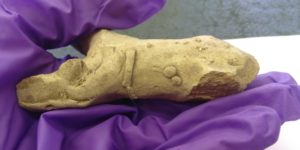

Figure 1 (Left), Reverse side of the Rider figure showing lines and small round lumps of clay, Figure 2 (Right), side of the horse rider figure again showing additions of clay.
The figurine of the horse is another example of additive clay work. Like the horse rider figure, the horse is anatomically incorrect and has small pieces of clay added to the body in a disorderly fashion. This could be for the purpose of decoration or denoting specific markings on the horse, as though modelled off of a real figure the artist had in mind. The saddle is also incomplete, with the clay strap not extending far enough to meet in the middle and instead being pushed into the underside of the horse to secure it in place. This is another indication of an unskilled craftsperson; they do not have the skillset to portray realistic details.
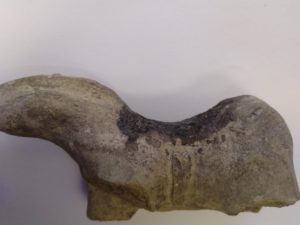
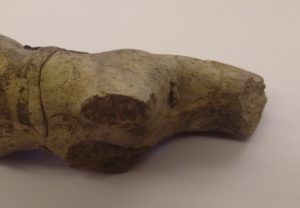
Figure 3 (left), side image of a horse figurine, head, legs and tail missing; Figure 4 (right) underside of horse figurine, showing small dots of clay as well as a band around the center of the image signifying the securing of a saddle.
There are distinct indicators of unskilled workmanship within the figures of the horse and rider. Following the list characteristics presented in Langdon’s study, there are signs that a child may have been involved in the production of the votive offering. The size of the figurines (the rider, figures 1 and 2, is 8.95cm tall, while the horse figurine, figures 3 and 4, is 9.38cm long) can be used to suggest that it may have been was an older child who created these pieces. We can conclude that these figures are the product of an unskilled craftsperson, and indicate the work of children through the additions of clay to the body of the pieces, the anatomical anomalies and the clear misunderstandings of how to express detail on the pieces.
The Two Horse Heads
Two fragmentary examples of horses’ heads also possess the characteristics of an inexperienced craftsperson. The image on the left, (figure 1), is a terracotta figurine of a horse’s head from the Met Museum. This example illustrates how an artist can use a subtractive technique to bring out details on the horse’s mane, nostrils, ears, and mouth, to replicate a realistic-looking horse.
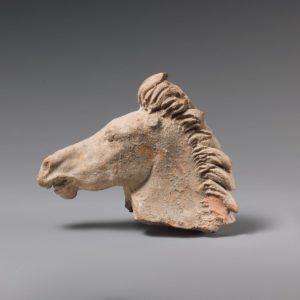
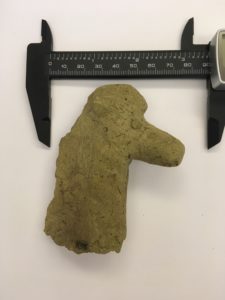
Figure 5 (left) 3rd Century Votive Offering from the Met Museum, Figure 6 (right) Miniature horses head
Regarding the example of a horse’s head from CAHA’s collection (Figure 6), the votive is clearly naively modelled in contrast to the example from the Met Museum. Comparing the two horses, it is clear that the artist who created Figure 5 had an understanding of a horse’s anatomy and possessed the skills to replicate this. Figure 6, on the other hand, is a more basic and unskilled representation of the animal. Another sign of unskilled craftsmanship is the use of an additive technique to create the eye. This can be considered as an indicator that the person who produced this offering was an amateur.
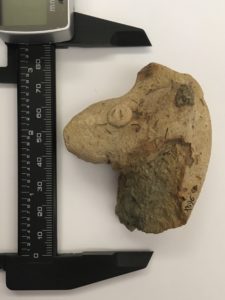
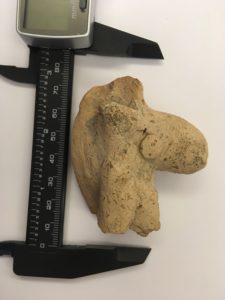

Figure 7 (left) Miniature horse head side 1, Figure 8 (Middle) Miniature horse head side 2, Figure 8 (right) Close up of the additive technique evident on the votive
Figure 7, the second example of a horses head from the CAHA collection strongly exhibits indicators of unskilled production. The use of an additive technique is apparent on the votive offering in the moulding of the eyes, and in the formation of the horse’s neck to ear (as can be seen in Figure 8 and 9). The extent of how asymmetrical of the two sides of the horse are to each other, eg. the wonky nose and haphazard positioning of the eyes, also suggests amateur craftsmanship. Furthermore, similarly to the Horse and Rider votive, there are no obvious firing problems. This suggests that, although made by an inexperienced creator, it was fired by someone skilled.
Overall we have been successful in applying Langdon’s study to the CAHA collection of votive offerings and have been able to detect key characteristics of unskilled craftsmanship, and possibly even child manufacturing. The appearance of additive techniques is a promising sign of amateur clay work that is consistent throughout all of the votives that we have analysed. Although we cannot know for certain that this amateur work instead of the lazy work of a more skilled artist, the characteristics we have identified definitely point towards unskilled production.
Bibliography
Langdon, S. 2013. ‘Children as learners and producers in early Greece’ in Grubbs, J.E. and T. Parkin (eds.) The Oxford Handbook of Childhood and Education in the Classical World (Oxford).
THE MET MUSEUM ‘Terracotta horse’s head’ https://www.metmuseum.org/art/collection/search/248370 (accessed 2 Dec 2020)
Figure 1, 2, 3, 4. (photograph: L. Sharp)
Figure 6, 7, 8, 9. (photograph: E. Durbin)
